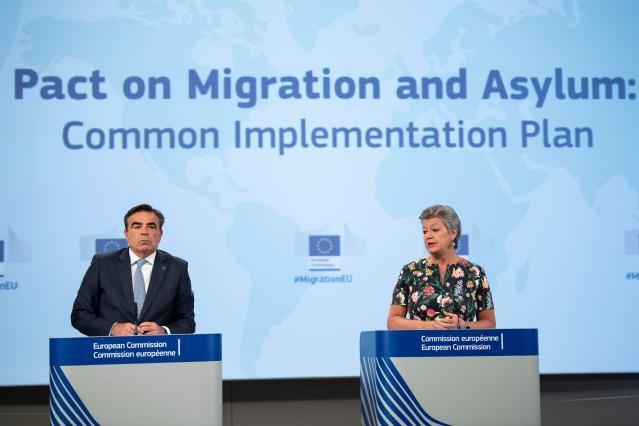The European Commission adopted on Wednesday a common implementation plan for the Pact on Migration and Asylum one day after it had entered into force.
The pact was adopted a month ago by the EU co-legislators after years of negotiations in what they described as a historic agreement. The Commission’s implementation plan sets out the key milestones for all member states to put in place the legal and operational capabilities required to successfully start applying the new legislation by mid-2026.
The adoption of the pact brought years of bitter negotiation to an end and was criticized for toughening the EU’s policy towards migrants, among others regarding conditions for asylum seekers at European borders through increased use of detention, including for families and children.
“Today we are presenting a blueprint for the next two years of work to help make the Pact on Migration and Asylum a reality on the ground,” Margaritis Schinas, Vice-President for Promoting our European Way of Life, said at a press briefing. Migration has to managed together by all member states, he added.
“This is further testament to the Commission’s determination to spare no effort in ensuring Member States have all the expertise, operational and financial support they need to turn legal commitments into practice. Not all member states are starting from the same point, but we will all cross the finish line together.”
Ylva Johansson, the Commissioner for Home Affairs, commented at the joint press briefing that the pact is not a Swedish “smörgåsbord” from which the member states can cherry-pick. The pact has to be implemented by all countries, with some flexibility, she underlined. According to her, the member states are eager to start with the implementation.
The pact has an external dimension and involves EU’s relations with the countries of origin and transit of migrants and asylum seekers. The EU has therefore a policy of pursuing comprehensive partnerships with partner countries, notably in the fight against migrant smuggling, effective returns, readmission and reintegration as well as legal pathways.
Some of the partner countries have been criticized for not respecting human rights. EU cannot promise that there never will be human rights violations in partner countries, the Commissioner admitted. The pact is closing loopholes in secondary movement of migrants and is expected to increase the currently low return rate of migrants whose asylum applications have been denied.
The implementation plan will be a common endeavour with the Commission supporting member states every step of the way, they assured. EU agencies will provide both operational and targeted support to them throughout the process. Although the pact already has entered into force, a lot of work will be required to implement it the deadline two years from now., according to the Commission.
The common implementation plan provides a template for the member states own national implementation plans that are due to be established by 12 December 2024. But before that, the member states will submit draft plans to the Commission.
During the second half of 2024, the rotating EU Presidency will be chaired by Hungary. Known for its anti-migration policy, it is expected to adapt to its role as chairing the EU Presidency and act in the common interest of all EU. “The time of negotiations is over,” commented Vice-President Schinas, “now it’s time for implementation.”
The implementation plan consists of 10 thematic areas or building blocks that are fundamentally interdependent and need to be implemented in parallel. A crucial issue in the application of EU’s asylum and return polices it the concept of safe countries, whether countries of origin or third countries.
The latter concept refers to a country where an asylum applicant has a connection and should have applied for asylum when fleeing from his country of origin. Currently, there is no common EU list on safe third countries, to which migrants can be returned, and each member state adopts its own list, which results in non-uniform application of the legislation.
The Commission might have preferred a common list but the co-legislators opposed it. Instead, under building block 4 (Fair, efficient, and convergent asylum procedures), the Commission commits to review the safe third concept by the end of the implementation period. The EU agency for asylum (EUAA) will provide the Commission with information on which countries that can be considered as safe.
The drafting of the EU list will be done in consultation with the member states. The EU list will not be binding and not replace their national lists but is expected to go some way in harmonizing the lists, possibly before the deadline.
Member states will also have to incorporate into their administrative procedures the notion of ‘effective protection’ in the return decisions (building block 5 on efficient and fair return procedures). This becomes even more important as the EU plans to speed up the decisions and issue them as part of a negative asylum decision.
In the return decision, member states will have to carry out an individual assessment of the risk of persecution of a person in the country to which he is returned (refoulement). This principle goes beyond the safe country concept because a person can risk persecution for political and other reasons in a country which is considered safe for the majority of its inhabitants.
M. Apelblat
The Brussels Times

